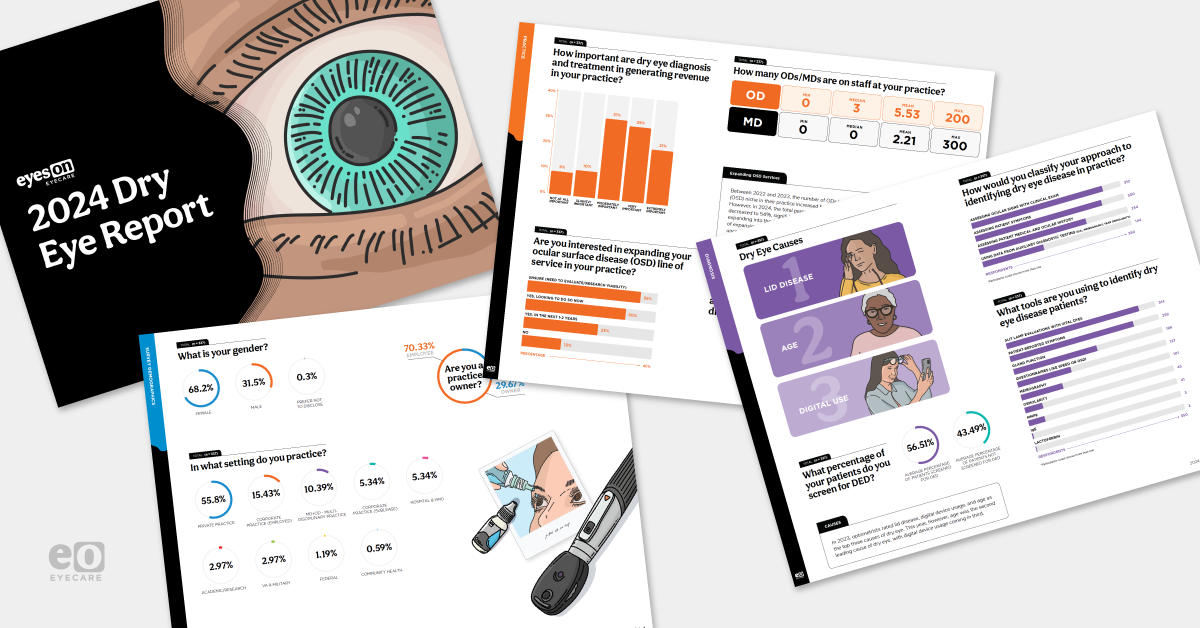Due to a range of intrinsic and extrinsic factors,
dry eye disease (DED) is on the rise. According to recent statistics, approximately 16 million Americans suffer from DED.
1 In response, both eyecare practitioners and the ophthalmic industry are stepping up to meet the challenge with advanced diagnostics,
innovations in treatment options, and a progressive, holistic approach to management.
Dry eye was ranked as the second top area of specialty of those surveyed—only exceeded by primary care—and will account for 43.39% of practices’ clinical focus over the next 12 months; this is up 16.54% from our 2023 survey results.
We posit from our research that this emphasis on DED is due to the rising prevalence, the increase in understanding of the multifactorial nature of the disease, and the expansion of treatment options.
In the 2024 Dry Eye Report, we thoroughly explore the emerging challenges within the realm of dry eye care. To ensure an optimal degree of accuracy, we gathered validated responses from a broad spectrum of eyecare professionals—from optometrists first entering the field to clinicians with a wealth of experience and decades in practice.
Download the 2024 Dry Eye Report now, or keep reading for a sneak peek at the findings!
📚
2024 Dry Eye Report
Developed with our colleagues in mind, the 2024 Dry Eye Report covers trends in dry eye diagnosis and management as well as tips for improving treatment outcomes with patient-focused care.
The 2024 Dry Eye Report covers:
- The intensifying clinical emphasis on dry eye
- Estimated pervasiveness of DED, Demodex blepharitis, and neuropathic corneal pain, along with top-ranked causes
- Preferred screening and diagnostic tools
- Confidence in treatment and ongoing management, along with favored therapies
- The likelihood of expansion of dry eye practice
- Valuable insights on thought trends, sorted into relevant themes with the assistance of natural language processing
- And more!
More than half of patients are estimated to have DED
Our respondents, the majority of whom are in private practice (55.8%), estimated that well over half of their patient population—67.55%—have some form of DED. The percentage of those patients diagnosed with DED dips to 46.38%.
This year’s survey put a special focus on
Demodex infestation, particularly its diagnosis and treatment. The participants were also polled about the prevalence of neuropathic corneal pain (NCP). The responses around these two topics reiterated the ever-emerging complexities within the dry eye patient population.
Utilizing all diagnostic tools available
The data above underscored the crucial need for increased patient awareness and universal screening practices to ensure no case goes underdiagnosed. Fortunately, nearly half (
46%) of respondents reported being “very confident,” while an additional one-third (
34%) identified themselves as “extremely confident” in accurately
diagnosing dry eye in their patients.
When it comes to diagnosis, respondents relied on multiple diagnostic tools, often used in tandem, to assess patients. These included slit lamp evaluations with
vital dyes, patient-reported symptoms, analysis of gland function, questionnaires (e.g., SPEED and OSDI),
meibography, osmolarity, and others.
Confidence in DED treatment is high
Once the diagnosis is complete, treatment begins—and most respondents reported they were confident in doing so, with 25% rating themselves as “moderately confident,” 51% as “very confident,” and 21% as “extremely confident.”
Optometrists surveyed were also quite certain in their ability to manage dry eye disease patients on an ongoing basis, as 44% reported they were “very confident,” and 21% stated they were “extremely confident.”
With many treatment options available, eyecare professionals emphasize the need for a holistic view of patient health and individualized plans to address the multifactorial nature of DED.
Both this year and in 2023, OTC topical treatments, such as artificial tears, lid scrubs, and
omega fatty acid supplements, were the most preferred treatment approach. However, in 2024, clinicians ranked patient education on lifestyle and environmental changes followed by daily eyelid hygiene therapy over prescription-based treatment as their next line of action.
In 2023, prescription-based treatment ranked second. This may indicate a shift toward a holistic approach to enhance patient care.
Expanding dry eye services
A combined total of 50% deemed dry eye diagnosis and treatment as either “very important” or “extremely important” in generating practice revenue. Our analysis also revealed a 13.89% increase in the clinical emphasis on dry eye, from 37.23% in 2023 to 42.4% in 2024. However, this does not directly align with plans to expand dry eye services.
This year, the number of optometrists committed to expanding dry eye services dropped to 54%, a 10.74% decrease from last year. Additionally, 35% of ODs felt further evaluation and research were needed to assess the viability of growing the dry eye aspect of their practice.
This signals a more cautious approach despite the escalating incidence of ocular surface disease (OSD) and the proliferation of diagnostic and treatment technologies.
Conclusion
We believe, along with statistical data, optometrists can glean some actionable advice from the overarching themes that emerged during our analysis, including:
- Screen every patient.
- Employ a holistic individualized treatment approach.
- Be adaptable.
- Understand that dry eye management is comprehensive eyecare.
- Invest in your practice’s long-term growth.
- Commit to education and continuous learning.
- Practice patient-centric care.
As optometrists gain a heightened awareness of DED and implement new techniques and technologies, we hope the
2024 Dry Eye Report empowers you to meet the challenges at hand.
